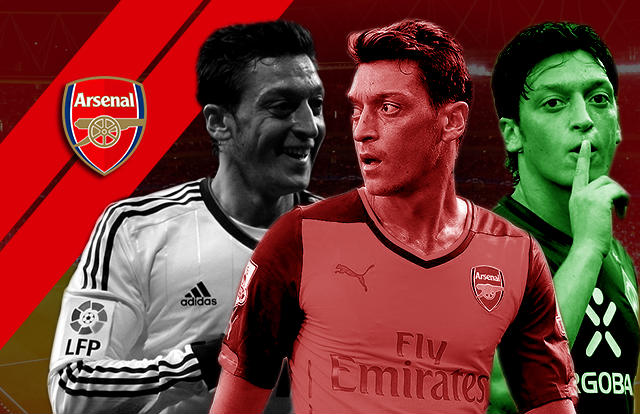The signing of Mesut Ozil was supposed to herald in a new era for Arsenal. After a lengthy rebuilding phase, the capture of Ozil was a much talked about transfer, a world class big money signing. It hasn’t quite worked out like that for the 25 year-old German yet and he’s not solely to blame according to Andrew Thompson.
As an Arsenal supporter of twenty years, I can categorically tell you about the pure state of elation that I was in when the news of Mesut Ozil’s signing broke last summer. This time last year, the Gelsenkirchen born playmaker was widely regarded by fans, pundits and managers alike (including Jose Mourinho, who managed him during his time at Real Madrid) to be the world’s premier number 10.
Blessed with incredible technical ability, awareness when on the ball, and the ability to pull the offensive strings as if he was Yo Yo Ma himself, it was thought by many that Ozil’s signing would usher in another era of creative genius to follow in the footsteps of Dennis Bergkamp and Cesc Fabregas. Fast-forward to the present, and there are few these days that still defend the German-born Turk (if they exist in any sort of significant number, point me in their direction, as they would be among friends).
While I continue to sing his praises, so many have begun to question why we brought him in at all, claiming he was a luxury signing given the fact that just the season before he came, we had purchased Santi Cazorla, while most just divulge into calling him over-rated; it takes every bit of self-control to not rip into people like that, but while I have had a close eye on him since his days at Werder Bremen, I get the impression that most Arsenal supporters have not been keeping tabs on him for nearly as long.
Having admired his brilliant abilities as a footballer, I can say beyond the shadow of a doubt that the problem is not Ozil, but rather that the problem is Arsene Wenger; Ozil is being misused at Arsenal in criminal fashion.
To begin, one can easily state their defense for him rather simply – at Bremen and Madrid, Ozil was the creative spark in two tactical systems that played aggressive counter attacking football, where the midfielders behind him would win the ball back, distribute to him, and then sit back and watch him work his magic. With players always willing to make forward runs into space, Ozil not only had plenty of options ahead of him to choose from, but he also had space to gallop if the opposition defense sat off of him and marked the forward runs. The unfortunate reality (and the more focused point of this article to continue with his defense a little deeper), is at Arsenal, he does not have that – on paper the likes of Theo Walcott, Alex Oxlade-Chamberlain, Alexis Sanchez and others are those pacey type of players who always want to get forward, but this is not put into practice, and Arsenal do not operate in this fashion.
Tactical comparisons
I am sure many will be up in arms with my questioning the tactics of a club I love (after all, is it not the predominant way of thinking these days that says if you love the club, you cannot possibly question anything about it? How dare I!), or my frustration with the ridiculous notions of Wenger, who is somehow unable to maximize the players he has at his disposal in using them in the position where they are best suited. That being said, let’s look at a graphic or two (well, three actually) that can corroborate my feelings on the matter;
Take a look at the above two graphics;
- At Bremen in the 2009/10 season, the three attacking players in front of Ozil were Claudio Pizarro, Marko Marin and Aaron Hunt; players that were always more than willing to drive forward and get into the final third. Marin and Hunt routinely made diagonal runs into the middle channels for Ozil to supply them over the top, or with a penetrating through ball. It should come as no surprise then, that Ozil registered 9 goals and 13 assists in what turned out to be his final season in the Bundesliga before moving to Madrid.
- While with Real Madrid, Ozil had much of the same options presented to him; Cristiano Ronaldo, Angel Di Maria and Karim Benzema were the players he usually had deployed in front of him. The desire of those three players to get forward and make things happen is common knowledge to even the most casual of football fans. While both Ronaldo and Di Maria did tuck in centrally as well, they didn’t do it with the intention of slowing down play, they did it to get a sniff at goal from outside the box, and always did it with pace. As for Benzema, well, that man lives in the box, so you always knew where his mind was. All told, in three seasons at the Bernabeu, Ozil racked up 19 goals and 47 assists, and that is just taking his numbers in La Liga into account (which work out to roughly 6 goals and a shade under 16 assists per season; brilliant numbers).
Now look at the third graph;
At Arsenal, the tactics deployed under Wenger are far more possession-based and build-up play rather than quick breaks or through the counter – therein lies the problem. With a fully fit squad, the Gunners would usually play with Santi Cazorla on the left, Theo Walcott on the right, and Olivier Giroud at striker, with Aaron Ramsey and Mikel Arteta behind Ozil.
Unlike during his time spent in Germany and Spain, at Arsenal, when Ozil receives the ball and looks up, he does not see players willing to make forward runs and breaking their necks to get into the box, he instead is presented with all his forward options no more than 10 yards away from him. Cazorla is more comfortable with playing centrally, so naturally he will tuck in to his comfort zone. Walcott has an increased eye for goal these days, so he is more inclined to come centrally as well rather than going wide and stretching the flank on the right. As for Giroud, he is more concerned with coming deeper to look for the ball and hold up play. When you add Ramsey into the mix coming from deep to get involved as well, what you have is a tactical system that is more likely to see the players sit down and play a bit of duck-duck-goose or patty cake than try to make it difficult for teams who are more than happy to sit compact in the middle and beg us to break them down.
What’s worse, is that not only do all these central runs take Ozil’s forward options away from him, it also affords him zero room to breathe when he is on the ball, and often he will lose possession because his options are not moving to give him an outlet. Simply put, when you have someone as creative as Ozil, and this is the best tactical system you can come up with, it smacks of mismanagement of the highest order. The good news (wait, there is good news? Why yes, yes there is!), is that there is hope on the horizon.
Where can Arsenal go from here?
With the purchases of both Alexis Sanchez earlier in the transfer window and Danny Welbeck on Deadline Day, Arsenal have the opportunity to switch gears and finally use Ozil the proper way.
Given that Giroud is out until at least the new year, either Sanchez or Welbeck will be called upon to fill the void at striker; both players are the type that love to get into the box and try to make things happen, while doing it with power and pace as well. With the imminent return of Theo Walcott to first team duties as well, this gives Ozil a trio of pacey attacking players that he can finally truly pull the strings for once more.
Looking at the above potential deployment now that business is concluded, Arsenal are in a far better position to play quick, incisive and penetrative football – a system that Ozil has a proven track record in. With Welbeck leading the line, and Sanchez and Walcott on the flanks, not only would they break forward with pace to give the opposition defense a three-pronged headache, but it also gives Ozil that extra bit of space any creative player would need; it could even see his goal tally rise from five last season to somewhere a little closer to ten (he’s hit nine on two separate occasions in his career).
Even if Sanchez or Walcott were not available for selection, or rotation was needed, Joel Campbell and Chamberlain could easily replace the first choice pair and do the same job effectively and without the side missing a beat going forward.
As for Ramsey and Wilshere, the space created by the forward runs of the attacking players also lends them more space as well, and while Ramsey is already arguably the club’s most effective and important player, it could help get the best out of Wilshere considering that he has stagnated in his development as of late.
The truth of the matter is, getting the best out of Ozil not only benefits him, but it benefits the players around him as well. As a Gooner through and through, I can only hope that more important eyes and ears are watching and listening to the possibilities that now exist for the club tactically. And while I may not be Arsene Wenger, I do have plenty of experience as both a player and a coach, so if I can see this, surely Le Prof can as well, and if he does, we can all sit back and watch the magic happen.
Written by Andrew Thompson
Read all our articles in the ‘Dial Square’ Team Blog.
- 20 Key Young Players to Watch from 20 Premier League Teams - August 10, 2018
- World Cup 2018: Germany Warning Signs - June 20, 2018
- MLS 2017: Top 5 U-22 Players of the Season - December 6, 2017
































































